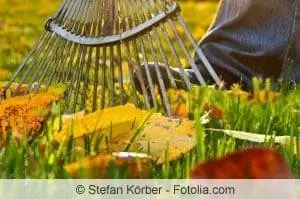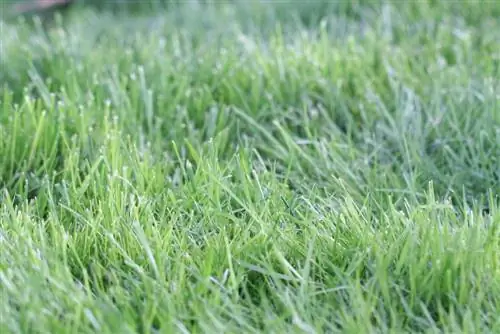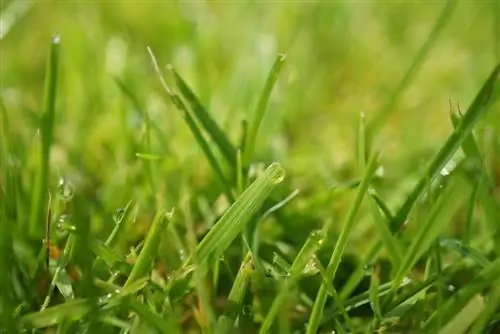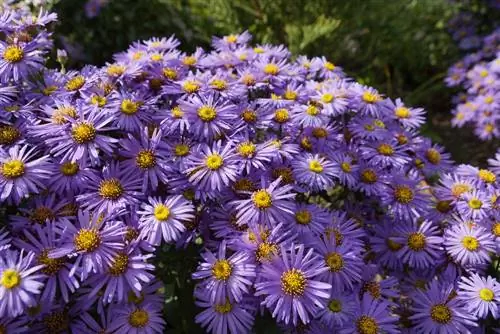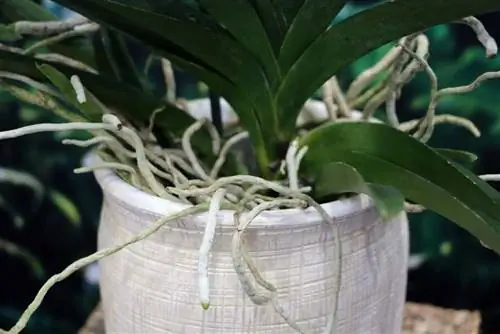- Author admin [email protected].
- Public 2023-12-17 03:39.
- Last modified 2025-06-01 06:48.
When autumn arrives in the ornamental and kitchen garden, there is still a lot to do for the hobby gardener. Now it's time to give the lawn special care so that it can withstand the rigors of winter. This is urgently needed because barbecue parties, children's birthday parties and summer drought have left their mark. A comprehensive treatment at the end of the gardening year ensures that the lawn thrives he althy and vital next spring. Find out all the important factors of proper lawn care in autumn below.
Clear away autumn leaves
What works excellently as a source of nutrients in the form of mulch between bushes and flowers, has a counterproductive effect on the lawn. If a blanket of autumn leaves accumulates here, light no longer reaches the blades of grass. Since a damp, cold climate develops at the same time, this process promotes the growth of moss. You can effectively prevent this shortcoming by sweeping up and disposing of the autumn leaves with a rake at least once a week. This autumn care measure also applies to fallen fruit. Collect not only fruit that is to be eaten, but also all fruit mummies.
Tip:
The autumn leaves can be removed from the lawn even faster with the help of the lawn mower. Set the device as high as possible and drive over the green area.
Mow the lawn properly in autumn
As the gardening year comes to an end, many hobby gardeners are unsure how long the lawn will still have to be mowed. The temperatures are dropping, it rains frequently and yet the blades of grass continue to grow. The lawn is no longer completely dry, so moist clippings stick together with the mower and the collecting container. In addition, the risk of the wet ground becoming increasingly compacted due to repeated walking or driving while mowing increases, with all the negative consequences for further growth. How to mow your lawn properly in autumn:
- As long as the weather permits, mow in the tried and tested rhythm
- Collect the grass clippings meticulously and never leave them lying around
- After the first frost, mow the lawn for the last time to a length of 4 centimeters
Don't stop mowing the lawn too early in the fall. As long as it doesn't freeze, the blades of grass will continue to grow. The negative consequences become apparent in spring when snowfall weighs down the grasses that are too tall. Fungi and diseases could spread, causing bare spots, brown spots and other lawn problems.
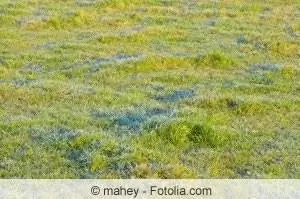
Fertilizing strengthens winter hardiness
Optimal lawn care in autumn cannot do without good fertilizer. Since completely different weather influences affect the green area than during the summer, other nutrients now come into focus. Instead of growth-promoting nitrogen, your lawn requires potassium in the fall. Potassium serves to strengthen the metabolism, thus creating reserves in the plant organism and promoting resistance. At the same time, potassium in the cell sap lowers the freezing point, which prevents frostbite. Specialist retailers offer a we alth of special autumn fertilizers for lawns, rich in potassium and low in nitrogen. Ideally, you should apply the fertilizer using a spreader in the dosage according to the manufacturer's instructions. In this way you can safely prevent overdoses and incorrect distribution. The lawn is then watered thoroughly.
Tip:
Cheaper in price, but just as effective for autumnal nutrient supply, is special lime with magnesium, potassium and sulfur. Well-known products are Patentkali and green lime.
Patentpotash - the reliable lawn fertilizer in autumn
Experienced hobby gardeners ignore expensive special fertilizers for the lawn and favor the inexpensive patent potassium. The preparation is not only inexpensive, but thanks to its composition it is suitable for almost all plants in the garden. Rich in potassium, Patentkali strengthens the tissue in roses just as effectively as in berry bushes, strawberries or lawn grass. In this interaction, magnesium takes on the task of giving the stalks a rich green color. This is how Patentkali is applied to the lawn:
- Patent potash is available in liquid form and granules
- Ideally administered in September with the pressure sprayer or spreader
- Then rain on the granules
- Only mow again when there are no more grains visible
It is important to note, that patent potash is not spread on parched ground. The lawn should be slightly damp to avoid burns.
Scarify older lawns - before the leaves fall
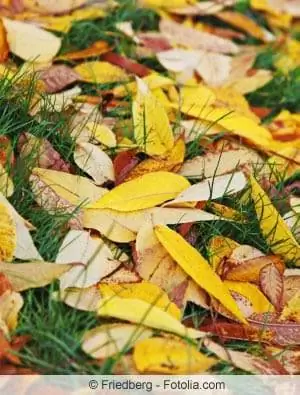
A lawn that is four years old or older tends to develop more moss and weeds. In this case, ventilating the green area in spring is no longer enough. Therefore, take a close look at the lawn when the first leaves wilt. If unsightly tangles appear, add scarifying to your care plan again. Here's how to do it:
- Best conditions prevail in dry weather and temperatures of 15-20 degrees Celsius
- First mow the lawn to a length of 4 centimeters
- Then use the scarifier to work the area lengthwise and crosswise
- Collect all plucked plant parts with a rake and dispose of them in the compost
Finally, the scarified grass area is treated with a special autumn fertilizer and watered extensively.
Repair damaged areas before winter
Depending on the level of stress during the summer, more or less large areas of damage appear in the lawn in the fall. Bare spots become particularly noticeable after scarifying. If you start repairing them in good time, you won't have to look at an unsightly patchwork carpet all winter long. In late summer and early autumn, the soil is still sufficiently warm so that fresh lawn roots can establish themselves well. The best prerequisites for success are after the lawn has been aerated. Reseeding is recommended as the most uncomplicated approach. In preparation, the scarified area is completely swept clear. You can also use the rake to loosen up bare and damaged areas because the scarifier blades do not reach deep enough. Sandy soil is enriched with clay powder, compacted soil is improved with a thin layer of sand. Then spread a thin layer of compost so that the seeds germinate more quickly. Now it pays off if you create an iron supply of seeds when you plant a new lawn. Knowledgeable hobby gardeners at least keep the packaging so that there is no need to puzzle over the variety name. After the preparatory work, it continues as follows:
- Apply starter fertilizer to bare areas
- Spread the seeds evenly
- Sift the light germinators with peat to a maximum height of 0.5 centimeters
- Water all reseeded areas of lawn with a fine spray
Although lawn seeds require a certain amount of light to germinate, a thin top layer makes sense. Otherwise, the seeds are exposed to washouts and pecking birds. You can get your lawn into shape even more quickly before autumn with the help of rolled turf. Reseeding closes gaps before winter in a simple way; However, patience is required until the new lawn grows there. The waiting time until sparse passages in the lawn close is significantly shortened with turf. Lawn schools not only supply large rolls to create an entire lawn, but also offer finished pieces for repair. The preparatory work does not differ from that for reseeding. Then lay the freshest possible pieces of turf next to each other along a straight edge. Use a sharp knife to give the repaired areas of the lawn the finishing touches. Last but not least, the lawn roller smoothes the turf to water it thoroughly. The lawn can be mowed again after an average of 8 to 14 days.
How to winterize your lawnmower
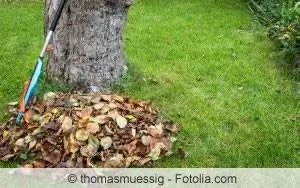
In addition to the lawn itself, the most important utensil for its care should also get through the winter well. Therefore, prudent hobby gardeners pay special attention to the lawnmower after the final cut.
- Clean the mower thoroughly
- Sharpen the cutting blades
- Emptying the engine mower's gas tank
- Check spark plugs and replace if necessary
- Remove any batteries and store separately at 10-15 degrees Celsius
Removing stuck-on grass residue from the exhaust and the cylinder cooling fins is of utmost importance because there is a risk of fire. Use a spatula or a brush to tackle the dirt. If you use the water hose for cleaning work, the jet must not damage the seals or bearings. Do not tilt the mower to the side to clean the underside. In this case, oil threatens to get into the air filter or into the exhaust, causing serious engine damage. It is more advantageous to tilt the device backwards with the spark plug pointing upwards. If the fuel cannot be easily dumped out of the tank, turn on the engine and let it run until it turns itself off.
Tip:
The lawnmower spends its hibernation in a dry, dust-free and forest-free area.
Conclusion
In autumn it becomes clear what toll the lawn has to pay to the stresses of summer. No green space should be left so stressed in the winter. Experienced hobby gardeners therefore carry out special lawn care in autumn. They pay attention to correct mowing, administer a potassium-rich fertilizer, do not leave any leaves on the lawn and scarify again if necessary. Anyone who is serious about proper lawn care in autumn can now repair sparse areas of lawn by reseeding or using rolled turf. Prepared in such a careful manner, even the harshest winter cannot harm the gardener's green business card. The course is now set for a he althy, vital start to the next gardening season.

